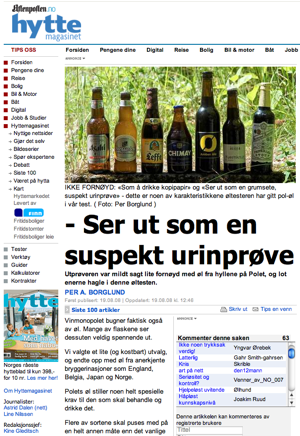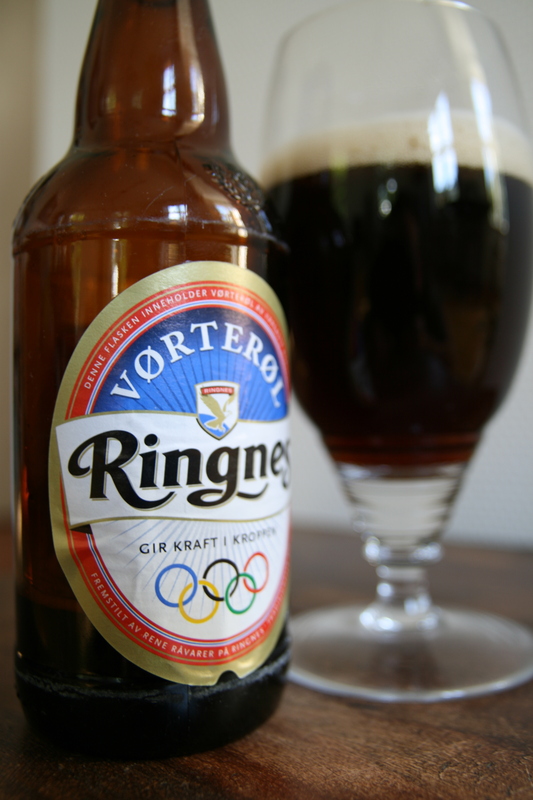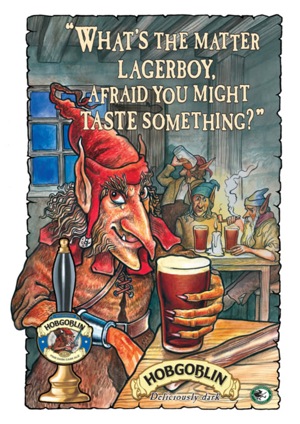How we judge beer in Norway

The offending article |
The state of the Norwegian beer scene never ceases to amaze me, and given that I'm a native Norwegian, I thought international readers might enjoy a look at what goes on here. If nothing else, it might have some entertainment value. The occasion for this blog entry is a beer test, initially published by a Norwegian magazine about cottages (as in summer houses, mountain retreats, etc). This magazine is owned by the media conglomerate Schibsted, which also publishes the main Norwegian daily, and so the test has now made its way onto the site of said daily. So the unwary reader could be forgiven for assuming that it was published by the most prestigious newspaper in Norway.
The premise of the test is that the reviewer has found that the Norwegian Wine Monopoly sells not just wine, but also beer, in "exciting" bottles. And so he has picked from six beers from "recognized beer nations like England, Belgium, Japan, and Norway". Norway is a recognized beer nation? Really? But let us put this down to an excess of national patriotism, and not quibble about the presence of Japan in the list, because, as we will find, there is more than enough else to complain about.
The reviewer then notes, apparently with some surprise, that the beer needs special treatment. For example, it has to be served at the right temperature. And some of it needs to stand still before serving to let the sediments settle. Already at this point certain reservations about the competence of the reviewer arise in the mind of readers with some basic knowledge of beer, but at least the reviewer has found this out before starting the test.
It's when we get to the beer reviews themselves that the article really gets interesting. For each beer some basic data is given (ABV, price, food pairings), a little background about it, the review, and a score from 1-6 (with 6 as the best).
Hoegaarden Wit
Let's start with the last beer: Hoegaarden Wit. As any beer enthusiast knows, this is a very highly esteemed world classic. In fact, this is the beer which revived the style, so that all the wit beers currently brewed were inspired by this single beer. A simplified estimate based on the RateBeer database tells me there must be at least 1000 such beers. Nothing in the article indicates that the reviewer has any awareness of any of these facts.
In fact, the reviewer is shocked on discovering that the beer is cloudy, and compares it to "a dodgy urine sample". That wit beers are supposed to be cloudy is something he appears to be blithely unaware of. He goes on to say that it "doesn't smell as bad, but is very bitter". (The reviewer uses two different words in Norwegian, but they both mean bitter.) That's it. That's the entire review. What the reviewer has to say about aroma and taste can be boiled down to two simple assertions: "doesn't smell bad", "is bitter".
Unfortunately for the reviewer, this is one of the least bitter beers you can find. This, in fact, is why it tends to be quite popular among women, and why it's often recommended as a starter beer for people who want to try something other than pilsener. And in fact the beer is less bitter than the average pilsener.
The reviewer then gives the beer the lowest score: 1. On RateBeer, out of 1961 reviewers, only 6 reviewers give it less than 1 on a scale from 5.0 to 0.5. In fact, RateBeer places 88% of the registered 70,000 beers below this one based on these 1961 ratings. So the reviewer's low opinion does not appear to be very widely shared, to put it mildly.
Leffe Brune

Wort beer |
This is the main Belgian-style brand of the huge brewing conglomerate that just bought Budweiser. In order words, this is not a minor beer in terms of sales, and while it's by no means considered one of the best Belgian-style beers, it's certainly considered one of the easiest to drink, and a good place to start to explore this part of the beer world.
Our reviewer thinks this "smells little". Actually, Leffe Brune has quite a lot of aroma. However, our reviewer tells us that he's kept these beers in the fridge for a half a day before pouring them. So maybe it was too cold? Or maybe the reviewer just doesn't have much of a sense of smell? This last theory sounds rather plausible, as he goes on to write that the beer has "an unidentifiable taste". Apart from noting that the beer is dark (big surprise, given the name), that's the entire substance of the review. Another oddity is that he compares the colour to that of wort beer (basically unfermented beer), which is an extremely obscure beer type. Is wort beer the only dark type of beer the reviewer is familiar with?
So this time around we got "smells little", "is dark", and "unidentifiable taste". The first of these is wrong, the second stated in the name of the beer, and the third is a statement about the ignorance of the reviewer, and not a statement about the beer.
He then proceeds to give it a 1. Out of 678 RateBeer reviewers, none have given this beer less than 1.
Asahi Super Dry
This is rather an odd beer to include on the list of six beers to review, since it's the only pale lager. This is Asahi's main export brand, and best described as a clean-tasting pale lager with a bare minimum of spiciness and maltiness in the taste. It's not entirely tasteless, but definitely a very bland beer. Checking RateBeer again, picking the first reviews that show up (and only the ones from people with more than 10 ratings), I get "boring" (#1), "inoffensive" (#2), "crisp" (#3), "plain" (#4), "nice" (#5), and so on.
Our reviewer offers that it "smells like pilsener" (by which he means pale lager). Which is an astute observation, given that a pale lager is exactly what this is. It also "looks like a pilsener". Again, nobody could deny it. However, as nobody could fail to make precisely this observation, it is not a terribly interesting statement. "Nice head." Sure. "Tastes almost nothing." And here we have a first: the reviewer has made a statement which is both correct and non-obvious! He then adds "and is really parching dry. Like paper. Yes, like drinking paper from the copy machine." Right. While the beer certainly has a slight crisp driness, describing it as "parching dry" is just wildly inaccurate. It's not much drier than the average Norwegian pale lager. (We'll pass over how you drink paper, whether paper really is almost entirely tasteless, and other such difficult questions.)
So, to summarize again, we are offered "smells like pale lager", "looks like pale lager", "nice head", "tastes almost nothing", and "parching dry". So out of 5 statements, three are blindingly obvious, one is wrong, and one is (wonder of wonders!) correct.
He hands out a score of 1 again. This time, out of 699 RateBeer reviewers, 21 agree with him. So while he's still in a very small minority, at least this time the minority has members other than himself.
Chimay Bleu

Dark beer |
Again, with the unerring precision of a sleepwalker, our reviewer has picked another world classic for review. This time a beer that really is brewed by monks, and one which for many years has been considered one of the high points of Belgian brewing. In fact, this beer is powerful enough to age, and some places they will sell you vintage bottles dating back to the early 80s.
Our reviewer observes that the beer is "nearly black". In fact, it's not entirely opaque black, and you can see dark brown light through it if you know how to do it. So not bad for this reviewer. "Smells little". This time, the blame cannot be put on the fridge, as at 9% alcohol with top-fermentation and spices this beer has a powerful aroma. This statement is just flat wrong. "The taste is nauseating." Well. I suppose this beer can be rather overpowering for those who find even Hoegaarden too dry, but even so this is not a very useful piece of information. It makes the reviewer nauseous. Ok, but why? Is it the sweetness? Is it the alcohol? Is it the shock on being exposed to a beer that really, definitively tastes rather a lot? Hard to say, and the reviewer offers little in the way of hints. He winds up by describing the beer as "filling". That is, it's like a dish that makes you feel full even when you have eaten little of it.
So, to summarize: "nearly black", "smells little", "taste is nauseating", and "filling". That's one right (if rather obvious), one wrong, and two statements that are mostly about the reviewer.
And what score does the reviewer assign to this beer, which based on 2112 RateBeer reviews is better than 99% of the beers in the world, and which Michael Jackson gave four stars out of four? That's right. He gives it a 1.
The other reviews
Our reviewer also covered Små Vesen Kvernknurr (1), Nøgne Ø Amber Ale (3), and Samuel Smith Imperial Stout (4), without doing much better. His reviews can be summarized as follows: Kvernknurr, "fresh aroma", "filling"; Nøgne Ø Amber, "tastes caramel", "filling"; Samuel Smith Imperial Stout, "pleasant aroma", "tastes of malts", "filling". So again most statements are either nonsensical, wrong, or uninformative. The "fresh aroma" and "tastes of malts", which while certainly not wrong, are still rather low on informational content, are as good as it gets.
Conclusion

Lagerboy |
Overall, the reviewer scores very low indeed on precision and informational content. The beer he does best on is Asahi Super Dry, which does tend to confirm the suspicion that he is unused to anything besides industrial pale lager. It seems fair to conclude that the reviewer has very little knowledge of beer beyond the industrial pale lager that is what Norwegians mostly drink. However, he has at least seen a wort beer (which, had he tasted it, he would almost certainly have considered very "filling" indeed). In fact, it doesn't seem too much of a stretch to conclude that he has found the experience of drinking beers with more than a minimum of taste to be something of a shock.
We can also conclude that the reviewer is more or less unable to describe the taste of beer. He can only find one or two words to describe each beer, and he often gets these words wrong. In fact, it's hard to avoid the impression that he hasn't really tried to describe these beers. Phrases like "dodgy urine sample" and "copy paper" rather suggest that the purpose here has more been to ridicule these beers than to review them in any serious way.
And this is what I find the most galling about this review. In Norway there is exactly one newspaper which writes about beer from the point of view of taste, and this is a small regional newspaper. In all other newspapers, beer is fizzy yellow stuff which should be as cheap as possible, and if there is anything beyond that to say about it it will be the mergers of huge industrial breweries or, at best, interesting pubs covered in travel articles.
Not long ago, for example, Aftenposten.no had an article about where to find the cheapest beer in New York. New York has fantastic selection of beer pubs, with selections beyond the wildest dreams of the citizens of nearly all European cities. But in Norwegian newspapers the focus is on finding cheap Budweiser, or at best Pabst Blue Ribbon. Who would write an article about where to find the cheapest wine in Paris?
Of course, the paper version of Aftenposten does carry a weekly column about wine, which to me seems competently written, and certainly far more serious than this so-called "test". This is more than a little odd for a country with millennia of beer tradition, and no wine production, but there you are. The idea has stuck in the minds of most Norwegians that wine is culture and refinement, while beer is cheap alcohol, and when confronted with beers which really are more than just cheap alcohol, the best our journalists can offer is "looks like a dodgy urine sample".
Similar posts
BrewDog Paradox whisky beers
I don't usually do beer reviews on this blog, but I got "reviewer copies" of the BrewDog Paradox Smokehead and Isle of Arran, and thought they were worth writing about
Read | 2009-02-15 13:35
Where kveik comes from
I've written before about the kveik research paper by Preiss, Tyrawa, and van der Merwe
Read | 2018-09-12 16:27
The sixth German Gose
When I heard there was a third gose in Goslar I didn't want to believe it
Read | 2010-07-17 11:44
Comments
Dave - 2008-08-21 02:06:08
This beer test represents the worst piece of journalism I have ever seen. If things like this could ever pass the editors of a newspaper I would be critical to anything else I read in that paper.
Alexander - 2008-08-21 04:42:13
Another embaressing display of Norwegian beer culture. One would think that Norwegian traditions (pale lagers are a recent invention considering our long history) would merit better beer knowledge and appreciation, but alas. The strong beers being forced into the Vinmonopolet is one reason for its decline, and shitty journalism about it is another. And you would think there would be a strong mead culture somewhere here, but no dice. Bizarre.
There's been an upswing in beer interest here in Norway the last few years (mostly through a better selection of ... um, pale lagers) and hopefully it will sprinkle some interest in non-lagers, Norwegian and not. Hey, I even spotted Pilsner Urquell at my local Rimi the other day, which at least is a pilsner with taste and a sense of decency ...
otakuden - 2008-08-21 09:14:59
that article has not one iota of accurate information in it. and what's even worse is that people who read it are going to believe it not knowing any better.
Gahr - 2008-08-21 09:20:53
If ignorance is bliss, this guy surely is a happy camper.
Jos Brouwer - 2008-08-23 18:27:30
Just send an e-mail to the author, and awaiting reactions:
Per,
You may already have seen the blog at http://www.garshol.priv.no/blog/175.html I completely agree with this blogger, I think your knowledge about beer is mere bullshit. Learn something about beer, before writing about it. Or stick to spoilt grapejuice, others refer to it as wine. And spread nonsense about that. I don't care about that, but please use the same nonsensical bullshit (it's good they put sulfate in it, to prevent further spoiling) for that.
And - oh yes, I do know a little bit about beer. I'm an international beer judge.
The Beer Nut - 2008-08-25 07:55:36
In fairness, those reviews sound a lot like some of my early blog posts...
Lojosang - 2008-08-27 16:24:59
You did not get paid to do those early blog posts though, did you?
Are Gulbrandsen - 2008-08-28 03:11:39
This must clearly be a case of a journalist who wanted free beer. But making a complete fool out of himself and his newspaper like this will certainly have a much greater cost that the actual cost of the beer, about 300 NOK.
Lene - 2008-09-12 02:38:44
Who the fuck is Beer?